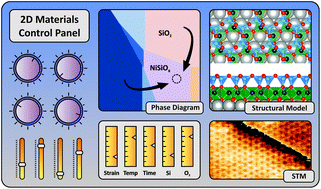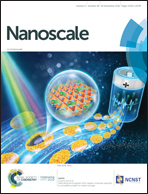Tuning two-dimensional phase formation through epitaxial strain and growth conditions: silica and silicate on NixPd1−x(111) alloy substrates†
Abstract
Two-dimensional (2D) materials can have multiple phases close in energy but with distinct properties, with the phases that form during growth dependent on experimental conditions and the growth substrate. Here, the competition between 2D van der Waals (VDW) silica and 2D Ni silicate phases on NixPd1−x(111) alloy substrates was systematically investigated experimentally as a function of Si surface coverage, annealing time and temperature, O2 partial pressure, and substrate composition and the results were compared with thermodynamic predictions based on density functional theory (DFT) calculations and thermochemical data for O2. Experimentally, 2D Ni silicate was exclusively observed at higher O2 pressures (∼10−6 Torr), higher annealing temperatures (1000 K), and more prolonged annealing (10 min) if the substrate contained any Ni and for initial Si coverages up to 2 monolayers. In contrast, decreasing the O2 pressure to ∼10−8 Torr and restricting the annealing temperature and time enabled 2D VDW silica formation. Amorphous 2D VDW silica was observed even when the substrate composition was tuned to lattice match crystalline 2D VDW silica. The trend of decreased O2 pressure favoring 2D VDW silica was consistent with the theoretical predictions; however, theory also suggested that sufficient Si coverage could avoid Ni silicate formation. The effect of epitaxial strain on 2D Ni silicate was investigated by modifying the solid solution alloy substrate composition. It was found that 2D Ni silicate will stretch to match the substrate lattice constant up to 1.12% tensile strain. When the lattice mismatch was over 1.40%, incommensurate crystalline domains were observed, indicating relaxation of the overlayer to its favored lattice constant. The limited epitaxial strain that could be applied was attributed to a combination of the 2D silicate stiffness, the insensitivity of its bonding to the substrate to its alignment with the substrate, and its lack of accessible structural rearrangements that can reduce the strain energy. The results demonstrate how the resulting 2D material can be manipulated through the growth conditions and how a solid solution alloy substrate can be used to maximize the epitaxial strain imparted to the 2D system.



 Please wait while we load your content...
Please wait while we load your content...